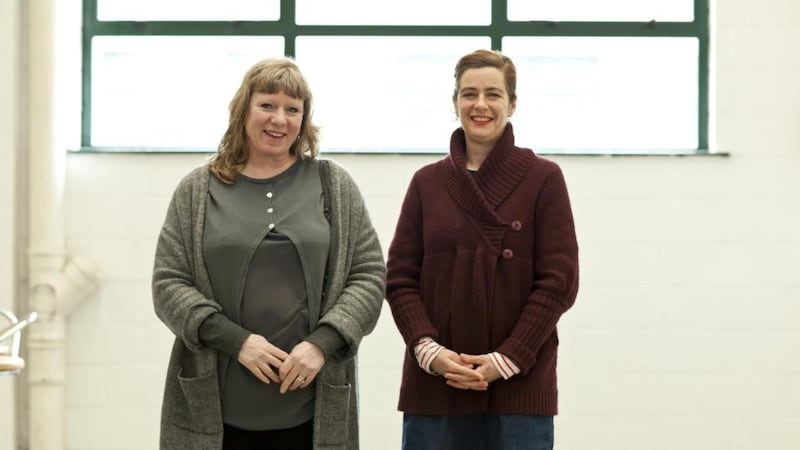Ramp – Roger O'Neill
The Complex, Dublin
★★★★
Temple Bar became a cultural quarter because the district was earmarked as a bus station. Relative dilapidation, short leases and low rent suited alternative enterprises. Much as the texture and character of the area has changed, the cultural dimension has survived, thanks to political foresight, sustained effort and some economic common sense, although nothing can be taken for granted.
During the recent bust, as property values fell, alternative cultural projects, including group studio schemes, struggled to gain or retain a foothold in Dublin, even though it seemed as if vacant commercial spaces were everywhere.


Nonetheless several schemes survived, not least because, within certain economic constraints, the provision of artists' workspaces is a modestly viable proposition, especially in buildings not suitable for conventional commercial use, and perhaps with the buffering of subsidy. Diversity of funding and the practical application of goodwill are hallmarks of cultural enterprise. Among thriving examples are Mart, which manages more than 50 studios in different locations, Talbot Gallery and Studios, La Catedral, Pallas Projects, New Art Studios and the Visual Arts Centre. A recent casualty, alas, was Broadstone Studios, but a couple of refugees for Broadstone have found a home in the Complex.
The Complex recently hosted an exhibition by one of its resident artists, Roger O’Neill, offering a chance to see into what might be described as one of the city’s unofficial arts centres. It occupies a corner site on Little Green and Little Mary streets, at the edge of a fruit and vegetable market and surrounded by wholesalers. It is surprisingly large within and comprises a big performance and exhibition space, nine artists’ studios and a second, flexible space that is under development.
Complex team
It is run by a small team including artistic director Vanessa Fielding, Annemarie Kilshaw, Anthony Goulding, Mark Wale and Stephen Bourke. They committed to a 10-year lease on the former fruit warehouse last April and embarked on preparatory work. The most arduous aspect was, Fielding notes, meeting fire safety regulations, which are stringent. After much toing and froing, they finally have certification. Dublin City Council has been exceptionally supportive.
The Complex’s history goes further back than April. Fielding’s background is in theatre. She could be described as a director, but rather than looking to direct a production from a text in a conventional theatrical space, she sees herself more as a theatre-maker, looking for ways to reframe the audience’s experience of performance. “I have three teenage children, and I know how difficult it is to interest them in theatre as it is generally understood,” she says.
Fielding is originally from Kent and began her training in classical theatre, directing a production of Brian Friel's Lovers at the Young Vic and later at the Lyric in Belfast. There she began to look for ways of operating outside the standard framework and she has not looked back since.
Her association with Dublin 7 goes back a long way. A landmark was her 1996 production Green, which took on the subject of violence against gay people. "We did it in a disused brewery on North King Street. I think it was one of Hilda Fay's first roles. The buzz was incredible."
A pattern of using vacant spaces as sites of cultural production was consolidated in 2008 when the developer Paddy Kelly gave the go-ahead to their occupancy of a building adjacent to the Light House cinema on Market Square, Smithfield.
“It was a fantastic space,” Fielding says. They began to invest in durable assets such as a large lighting rig and other facilities. Everything changed when Nama took control in 2011. “They were not open to discussions on negotiating a lease. In fact they weren’t open to anything. They just wanted us out.” And, after a vain bid in the courts to encourage Nama to negotiate, “they did kick us out”.
They were again forced into a peripatetic existence of temporarily occupying spaces. But they remained determined and organised. “I realised that I’d gained a lot of knowledge about how to keep going. It wasn’t that I wanted that kind of knowledge, just that I had to have it.”
When the Little Green Street premises came into view, they were equipped to try and make it work. “We’re lucky in having a very good board. And we are an artist- based organisation. Artists have to be optimistic, by definition.”
And she is optimistic. Among the studio residents are such well-established painters as Mairéad O'hEocha and Stephen Loughman, textile designer Niamh McAlister, photographers Steve McCullagh and Robert Benson and a strong contingent of performance artists.
That's not surprising given Fielding's commitment to live, interdisciplinary arts. The performance-art platform Livestock, founded by Francis Fay, Louise Ward and Joan Healy, is based at the Complex. Fielding is planning an ambitious staging of Arthur Miller's controversial Playing for Time, based on Fania Fénelon's memoir of the women's orchestra at Auschwitz. Also, the PhotoIreland festival is due to use the Complex as one of its main venues this year.
O'Neill's mixed-media works in Ramp are not directly representational, but they suggest an interest in the immediate, urban terrain, from inner-city locations and communities to vacant sites and the city's coastal fringe, opening out on to Dublin Bay. There is a restless, mutable, bricolage quality to the richly textured compositions, an acceptance that change and the necessity for improvisation are non- negotiable.
O'Neill favours gritty textures with occasional bursts of unexpected radiance and calm. The works are a good reflection of urban life and, you could say, creative life in the inner city. February 25th-March 2nd, thecomplex.ie










